ASUS Transformer Book T100 Review: Redefining the Entry-Level Windows Notebook
by Anand Lal Shimpi on October 18, 2013 12:00 AM ESTCPU Performance
The Atom Z3740 in the T100 features a 9% lower base clock and 22.5% lower max turbo frequency than the Z3770 we previewed back at IDF. Given how good of a job Bay Trail does turboing up to max frequencies under normal use, I’d expect proportionally lower scores in our tests.
I’ll start with our cross platform browser based benchmarks before moving on to a look at the Z3740 vs. Z3770.
Note for all of these benchmarks I’ve used Google’s Chrome browser. IE11 integrates well into the modern UI of Windows 8.1 but is otherwise a pretty terrible browser by comparison. I think the modern UI Chrome experience on 8.1 isn’t as good, but it’s a better/faster/less-finicky option. Out of all of our tests only SunSpider seems to run quicker under IE11, whereas Chrome wins everywhere else. I think it’s a bit insane to switch between browsers based on the benchmark being run, so we’re sticking with Chrome across the board.
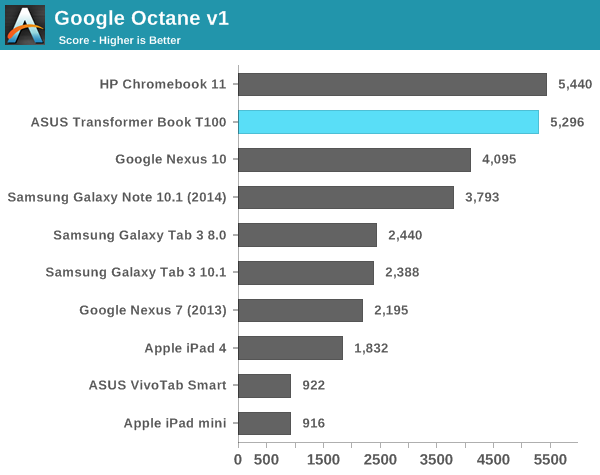
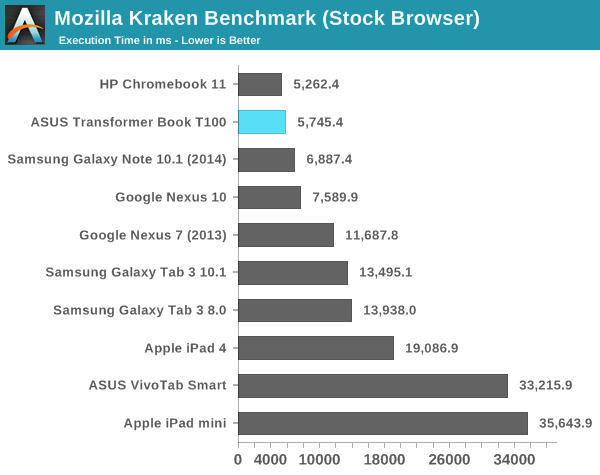
Lightly threaded performance is actually quite comparable to the Chromebook 11, which was a bit surprising. Throw a multitasking workload at the two notebooks and you'll separate the boys from the men though:
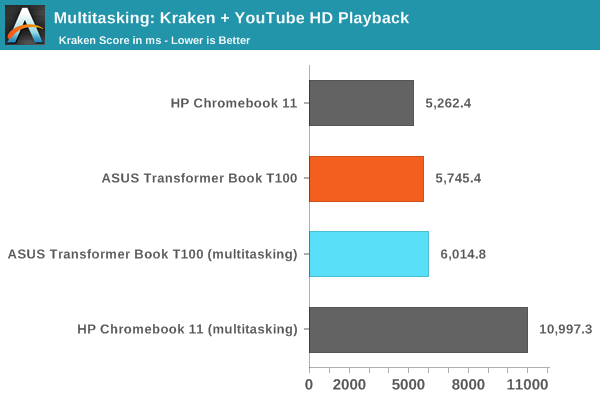
Chrome under Chrome OS performs extremely well for obvious reasons. But here the T100's additional cores and solid memory interface really come in handy when multitasking, there's hardly any performance penalty for this sort of multitasking on Bay Trail while the dual-core Cortex A15 based Chromebook needs serious help.

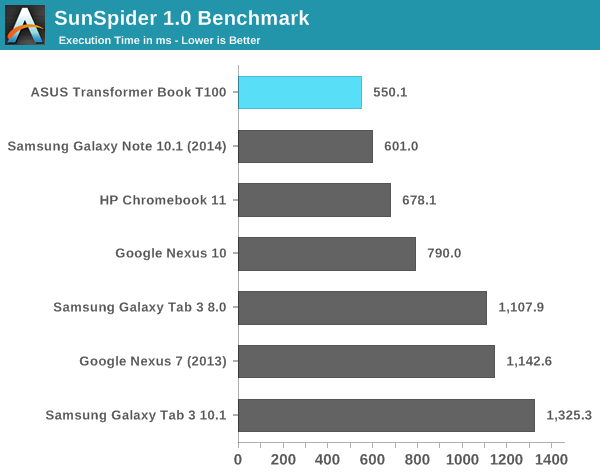
The T100 remains extremely competitive compared to the Chromebook 11 and definitely compared to Android tablets.
Next up is putting the Atom Z3740's performance in perspective compared to our earlier FFRD data:

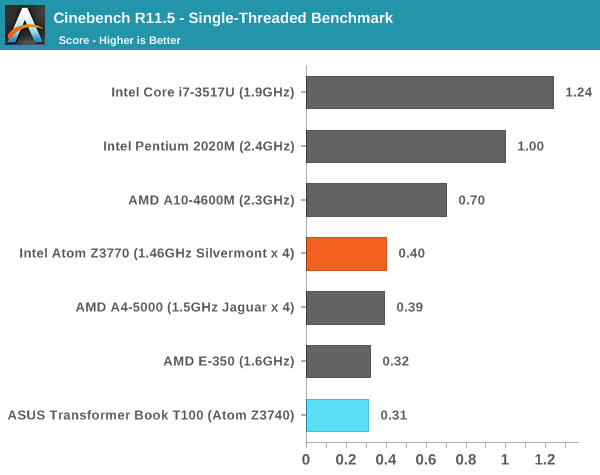


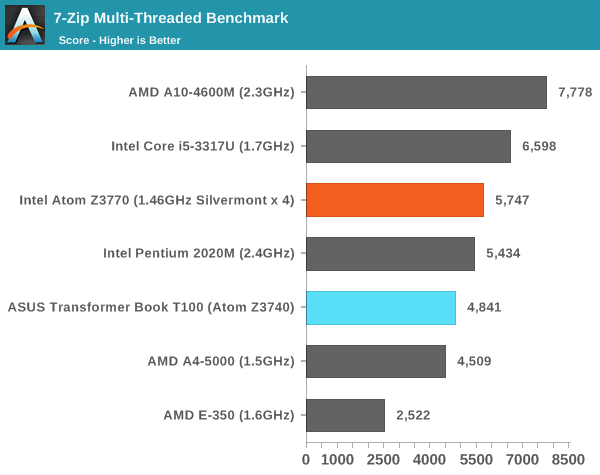
In all of these tests we see nearly perfect scaling compared to the Atom Z3770. Turbo frequencies are regularly hit when under load, and as a result see see proportionally lower performance from the T100. I would’ve liked to have seen the Z3770 used in the T100, but not if it meant a higher price, an optional dock or a worse display.
GPU Performance
I didn’t have a ton of time to go through gaming performance on the T100, but with a quarter of the EUs of Ivy Bridge it’s clear that you shouldn’t expect a GPU monster out of Bay Trail. In our cross platform graphics tests however the T100 is quite competitive, although not industry leading by any means.
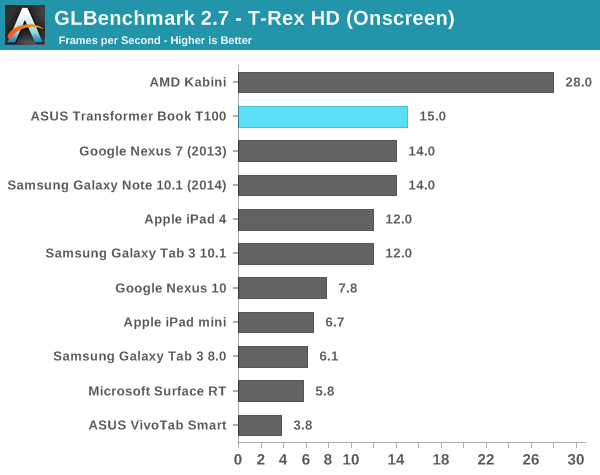
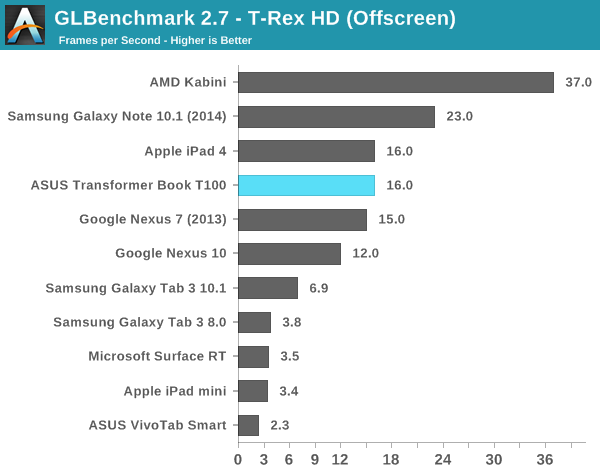
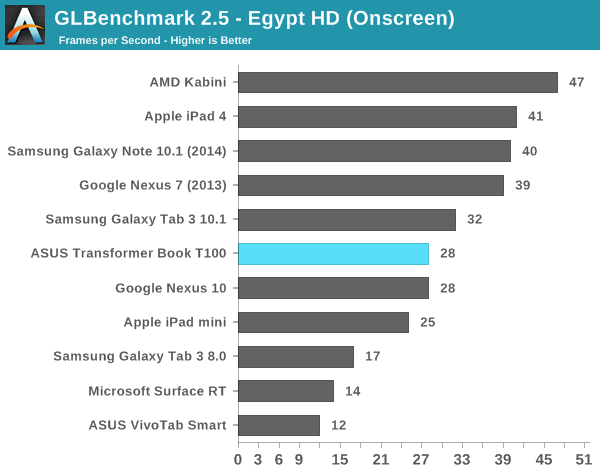
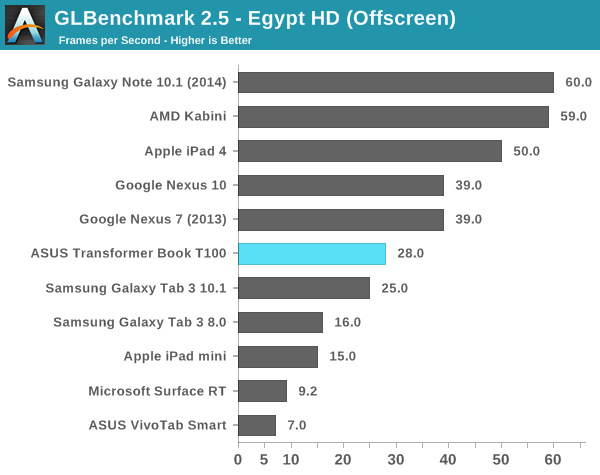
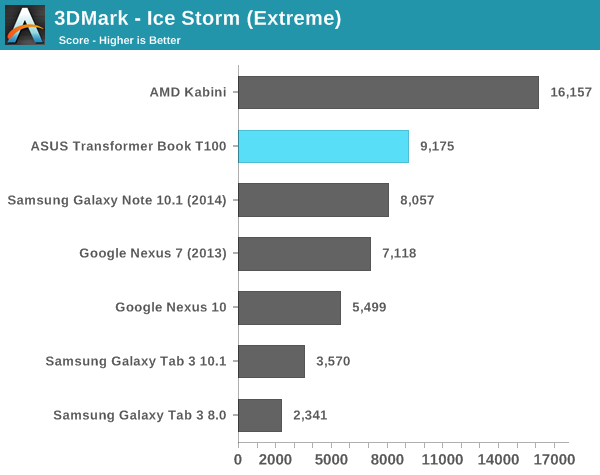

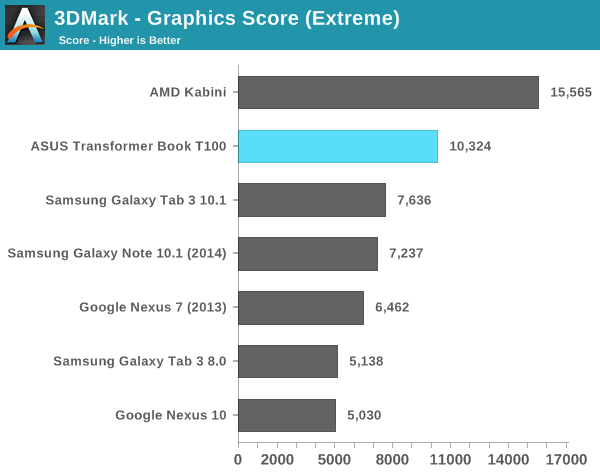
I did see some choppy animations at times and indications that the GPU (or its drivers) weren’t up to snuff, but that’s exclusively in classic desktop mode. In the modern UI, the Atom Z3740 was very smooth.
Storage Performance
Our Android IO tests rely on Androbench with a relatively limited LBA span. I increased the difficulty of the test a bit under Windows 8.1 but still kept it reasonable since we are dealing with eMMC solutions. I’m testing across a 1GB LBA span and testing for a period of 1 minute, which is an ok balance between difficulty of workload and sensitivity to the fact that we’re evaluating low-class SSDs here.
Sequential read and write performance is competitive with the high-end examples we’ve seen in the Android space. Random read performance is similarly good, while random write performance is appreciably better than what we’re used to in Android tablets. It is good to see ASUS/Intel/Microsoft concerned about random write performance, but I’d still like to see a 5 - 10x increase in these numbers with a focus on sustained performance before I’m truly happy.
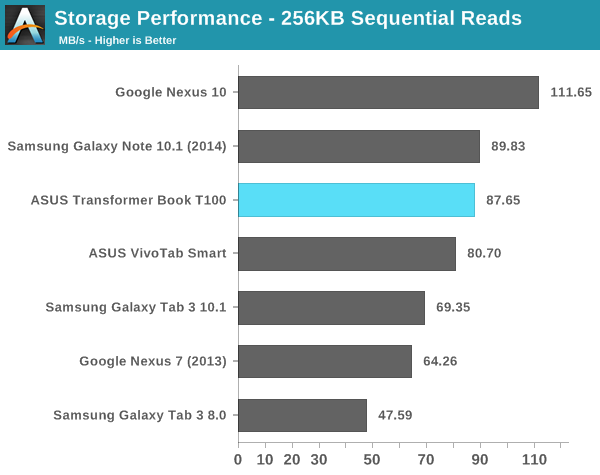
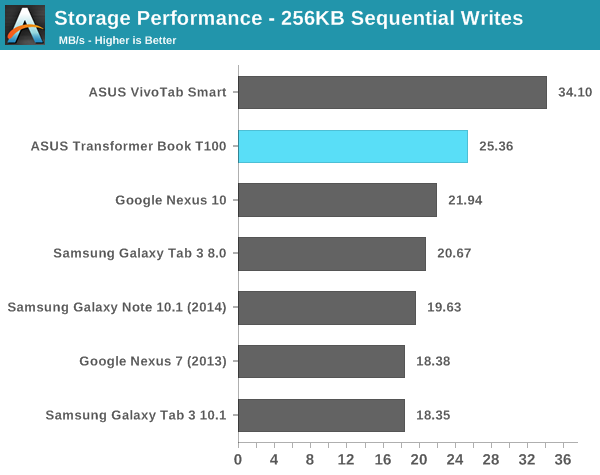
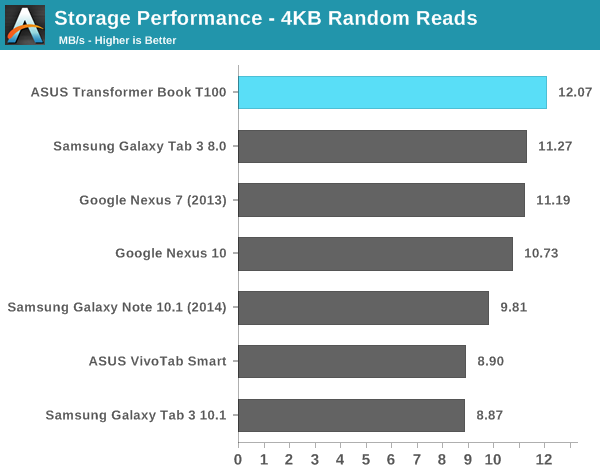
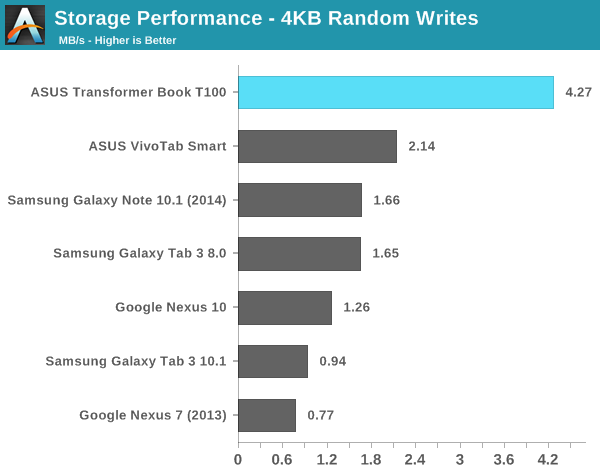










158 Comments
View All Comments
axien86 - Friday, October 18, 2013 - link
The pricing of the Asus T100 with 10" display in a toylike "plasticky" case priced around $400 for only 2GB of memory and no SATA drive capability shows how limited options OEMs have with Baytrail Atoms. It loses especially badly in graphics to a quad core Kabini.By comparison, the Toshiba Satellite 15.6 Touchscreen C55DT-A5307 sells for $399.99 and comes with quad core A6-5200 Kabini, 4GB memory and 500GB drive. Users can upgrade to more memory and SSD drives. By any comparison, it is a much better value and provides overall great PC user experience versus limited Asus T100 for the same price.
http://www.bestbuy.com/site/toshiba-satellite-15-6...
fokka - Friday, October 18, 2013 - link
you are comparing two completely different machines.Hubb1e - Friday, October 18, 2013 - link
A 15.6" laptop meets a completely different use case than a 10" tablet hybrid. The Tablet is a portable consumption machine that can do some work in a pinch. A 15.6" laptop is a work / play machine that can be portable. I don't see shoppers really cross shopping the two. I see people with both.Friendly0Fire - Saturday, October 19, 2013 - link
Plus, with stuff like a TN display (of the same resolution but 5" larger, no less!) and a mechanical hard drive, the user experience most likely suffers. You're trading size for cheapness.nushydude - Wednesday, November 6, 2013 - link
Can you tell us how the factory restore works? Is there a proprietory backup software? Or does it use Windows Refresh? How do you refresh it if you cannot boot into Windows? Is there a special key combination that would cause it to enter the recovery mode when pressed? Can you completely remove the recovery partition from the drives and make a USB recovery drive in case you are going for the 32GB model?Tams80 - Saturday, October 19, 2013 - link
http://globalsp.ts.fujitsu.com/dmsp/Publications/p...This might be of interest to you. You'll be paying far more than $10 extra though.
timon_comment - Saturday, October 19, 2013 - link
Waiting a look in Bay Trail M + SATA,in Windows x86 OS I dislike the eMMC storage system, it is an execrable design, the heavyweight Windows x86 OS is fully unlike in the lightweight Android OS, Windows needs SATA and PCIe, but Atom Bay Trail T is still no support SATA and PCIe.
Intel actually wanted in Android to compete with ARM processor, does not really want Bay Trail T to help Windows tablet to compete market, because the x86 processor is almost no another competitor! Now is Intel wanted to control the Android market!
lmcd - Sunday, October 20, 2013 - link
Would've been great to up the price by $15 for that, or $25 for that and RAM. Then good margins still, but good benefit for consumers.tinaaa - Monday, October 21, 2013 - link
The Z3770 is probably similar in battery life/size/cost/weight. I'm guessing price points was the key. It would have been nice to offer the 64GB version with the upgraded CPU.stanwood - Monday, October 21, 2013 - link
It may be the case that Intel could not supply the Z3770 in sufficient volumes. This is often true for the top-range part number early in a design's life cycle.